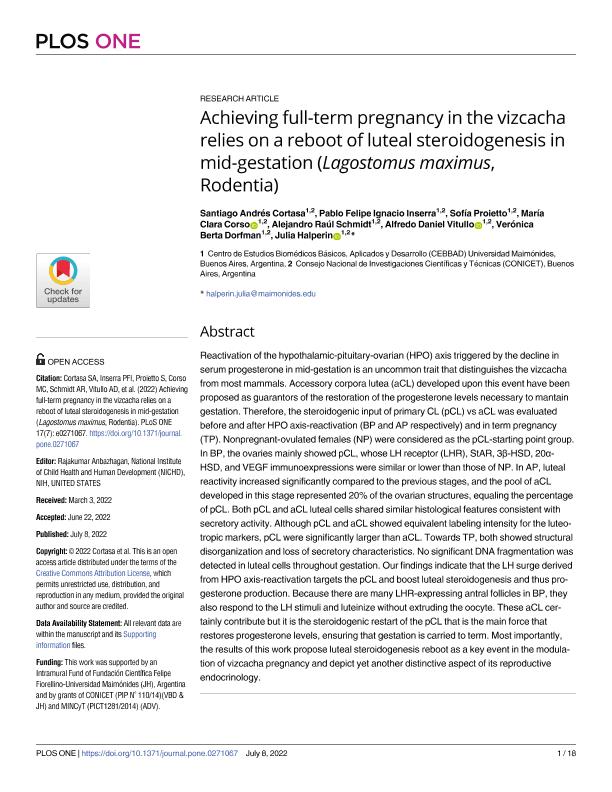Mostrar el registro sencillo del ítem
dc.contributor.author
Cortasa, Santiago Andrés

dc.contributor.author
Inserra, Pablo Ignacio Felipe

dc.contributor.author
Proietto, Sofia

dc.contributor.author
Corso, María Clara

dc.contributor.author
Schmidt, Alejandro Raúl

dc.contributor.author
Vitullo, Alfredo Daniel

dc.contributor.author
Dorfman, Verónica Berta

dc.contributor.author
Halperin, Julia

dc.date.available
2023-12-18T13:50:01Z
dc.date.issued
2022-07
dc.identifier.citation
Cortasa, Santiago Andrés; Inserra, Pablo Ignacio Felipe; Proietto, Sofia; Corso, María Clara; Schmidt, Alejandro Raúl; et al.; Achieving full-term pregnancy in the vizcacha relies on a reboot of luteal steroidogenesis in mid-gestation (Lagostomus maximus, Rodentia); Public Library of Science; Plos One; 17; 7-2022; 1-18
dc.identifier.issn
1932-6203
dc.identifier.uri
http://hdl.handle.net/11336/220575
dc.description.abstract
Reactivation of the hypothalamic-pituitary-ovarian (HPO) axis triggered by the decline in serum progesterone in mid-gestation is an uncommon trait that distinguishes the vizcacha from most mammals. Accessory corpora lutea (aCL) developed upon this event have been proposed as guarantors of the restoration of the progesterone levels necessary to mantain gestation. Therefore, the steroidogenic input of primary CL (pCL) vs aCL was evaluated before and after HPO axis-reactivation (BP and AP respectively) and in term pregnancy (TP). Nonpregnant-ovulated females (NP) were considered as the pCL-starting point group. In BP, the ovaries mainly showed pCL, whose LH receptor (LHR), StAR, 3β-HSD, 20α- HSD, and VEGF immunoexpressions were similar or lower than those of NP. In AP, luteal reactivity increased significantly compared to the previous stages, and the pool of aCL developed in this stage represented 20% of the ovarian structures, equaling the percentage of pCL. Both pCL and aCL luteal cells shared similar histological features consistent with secretory activity. Although pCL and aCL showed equivalent labeling intensity for the luteotropic markers, pCL were significantly larger than aCL. Towards TP, both showed structural disorganization and loss of secretory characteristics. No significant DNA fragmentation was detected in luteal cells throughout gestation. Our findings indicate that the LH surge derived from HPO axis-reactivation targets the pCL and boost luteal steroidogenesis and thus progesterone production. Because there are many LHR-expressing antral follicles in BP, they also respond to the LH stimuli and luteinize without extruding the oocyte. These aCL certainly contribute but it is the steroidogenic restart of the pCL that is the main force that restores progesterone levels, ensuring that gestation is carried to term. Most importantly, the results of this work propose luteal steroidogenesis reboot as a key event in the modulation of vizcacha pregnancy and depict yet another distinctive aspect of its reproductive endocrinology.
dc.format
application/pdf
dc.language.iso
eng
dc.publisher
Public Library of Science

dc.rights
info:eu-repo/semantics/openAccess
dc.rights.uri
https://creativecommons.org/licenses/by-nc-sa/2.5/ar/
dc.subject
ovary
dc.subject
pregnancy
dc.subject
corpus luteum
dc.subject
progesterone
dc.subject
vizcacha
dc.subject.classification
Biología Reproductiva

dc.subject.classification
Ciencias Biológicas

dc.subject.classification
CIENCIAS NATURALES Y EXACTAS

dc.title
Achieving full-term pregnancy in the vizcacha relies on a reboot of luteal steroidogenesis in mid-gestation (Lagostomus maximus, Rodentia)
dc.type
info:eu-repo/semantics/article
dc.type
info:ar-repo/semantics/artículo
dc.type
info:eu-repo/semantics/publishedVersion
dc.date.updated
2023-12-18T12:04:47Z
dc.journal.volume
17
dc.journal.pagination
1-18
dc.journal.pais
Estados Unidos

dc.journal.ciudad
San Francisco
dc.description.fil
Fil: Cortasa, Santiago Andrés. Universidad Maimónides. Área de Investigaciones Biomédicas y Biotecnológicas. Centro de Estudios Biomédicos, Biotecnológicos, Ambientales y de Diagnóstico; Argentina. Consejo Nacional de Investigaciones Científicas y Técnicas; Argentina
dc.description.fil
Fil: Inserra, Pablo Ignacio Felipe. Consejo Nacional de Investigaciones Científicas y Técnicas; Argentina. Universidad Maimónides. Área de Investigaciones Biomédicas y Biotecnológicas. Centro de Estudios Biomédicos, Biotecnológicos, Ambientales y de Diagnóstico; Argentina
dc.description.fil
Fil: Proietto, Sofia. Consejo Nacional de Investigaciones Científicas y Técnicas; Argentina. Universidad Maimónides. Área de Investigaciones Biomédicas y Biotecnológicas. Centro de Estudios Biomédicos, Biotecnológicos, Ambientales y de Diagnóstico; Argentina
dc.description.fil
Fil: Corso, María Clara. Universidad Maimónides. Área de Investigaciones Biomédicas y Biotecnológicas. Centro de Estudios Biomédicos, Biotecnológicos, Ambientales y de Diagnóstico; Argentina. Consejo Nacional de Investigaciones Científicas y Técnicas; Argentina
dc.description.fil
Fil: Schmidt, Alejandro Raúl. Universidad Maimónides. Área de Investigaciones Biomédicas y Biotecnológicas. Centro de Estudios Biomédicos, Biotecnológicos, Ambientales y de Diagnóstico; Argentina. Consejo Nacional de Investigaciones Científicas y Técnicas; Argentina
dc.description.fil
Fil: Vitullo, Alfredo Daniel. Consejo Nacional de Investigaciones Científicas y Técnicas; Argentina. Universidad Maimónides. Área de Investigaciones Biomédicas y Biotecnológicas. Centro de Estudios Biomédicos, Biotecnológicos, Ambientales y de Diagnóstico; Argentina
dc.description.fil
Fil: Dorfman, Verónica Berta. Universidad Maimónides. Área de Investigaciones Biomédicas y Biotecnológicas. Centro de Estudios Biomédicos, Biotecnológicos, Ambientales y de Diagnóstico; Argentina. Consejo Nacional de Investigaciones Científicas y Técnicas; Argentina
dc.description.fil
Fil: Halperin, Julia. Universidad Maimónides. Área de Investigaciones Biomédicas y Biotecnológicas. Centro de Estudios Biomédicos, Biotecnológicos, Ambientales y de Diagnóstico; Argentina. Consejo Nacional de Investigaciones Científicas y Técnicas; Argentina
dc.journal.title
Plos One

dc.relation.alternativeid
info:eu-repo/semantics/altIdentifier/url/https://journals.plos.org/plosone/article?id=10.1371/journal.pone.0271067
dc.relation.alternativeid
info:eu-repo/semantics/altIdentifier/doi/https://doi.org/10.1371/journal.pone.0271067
Archivos asociados
